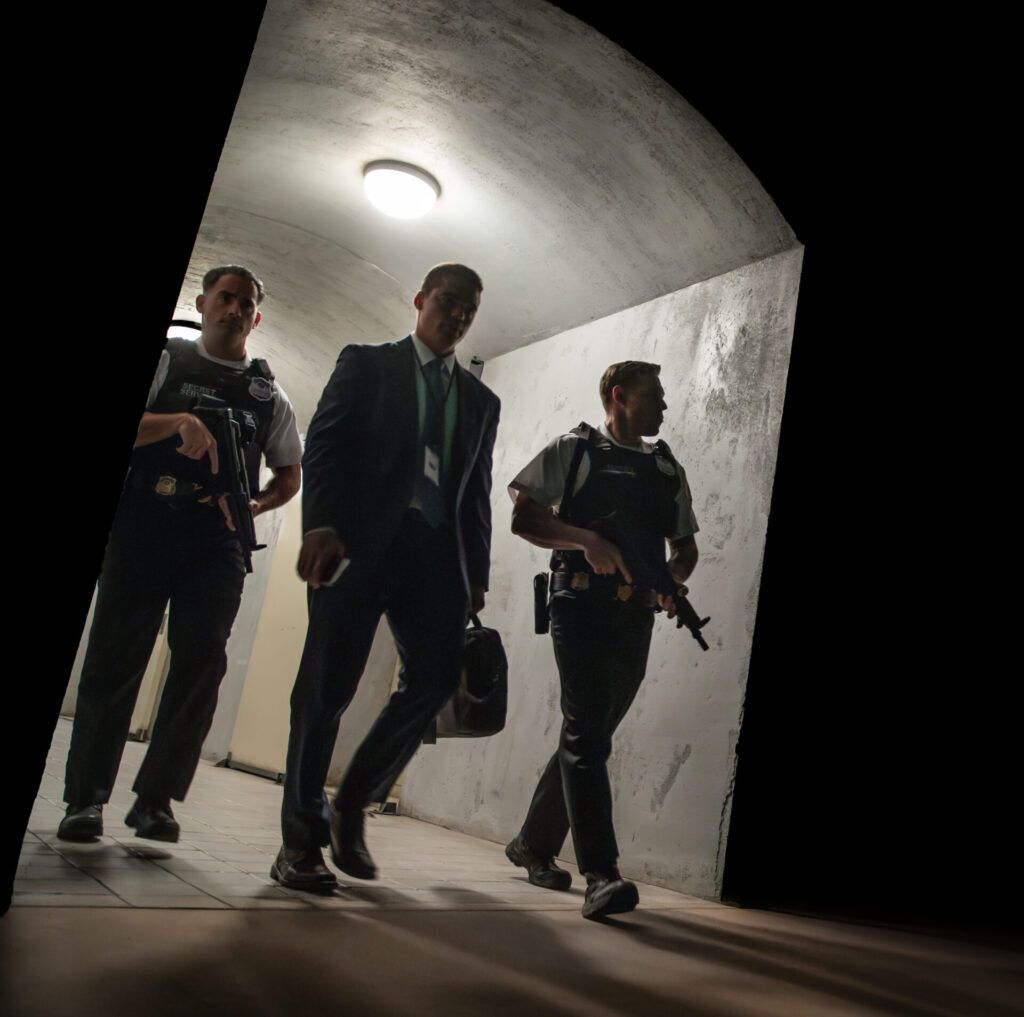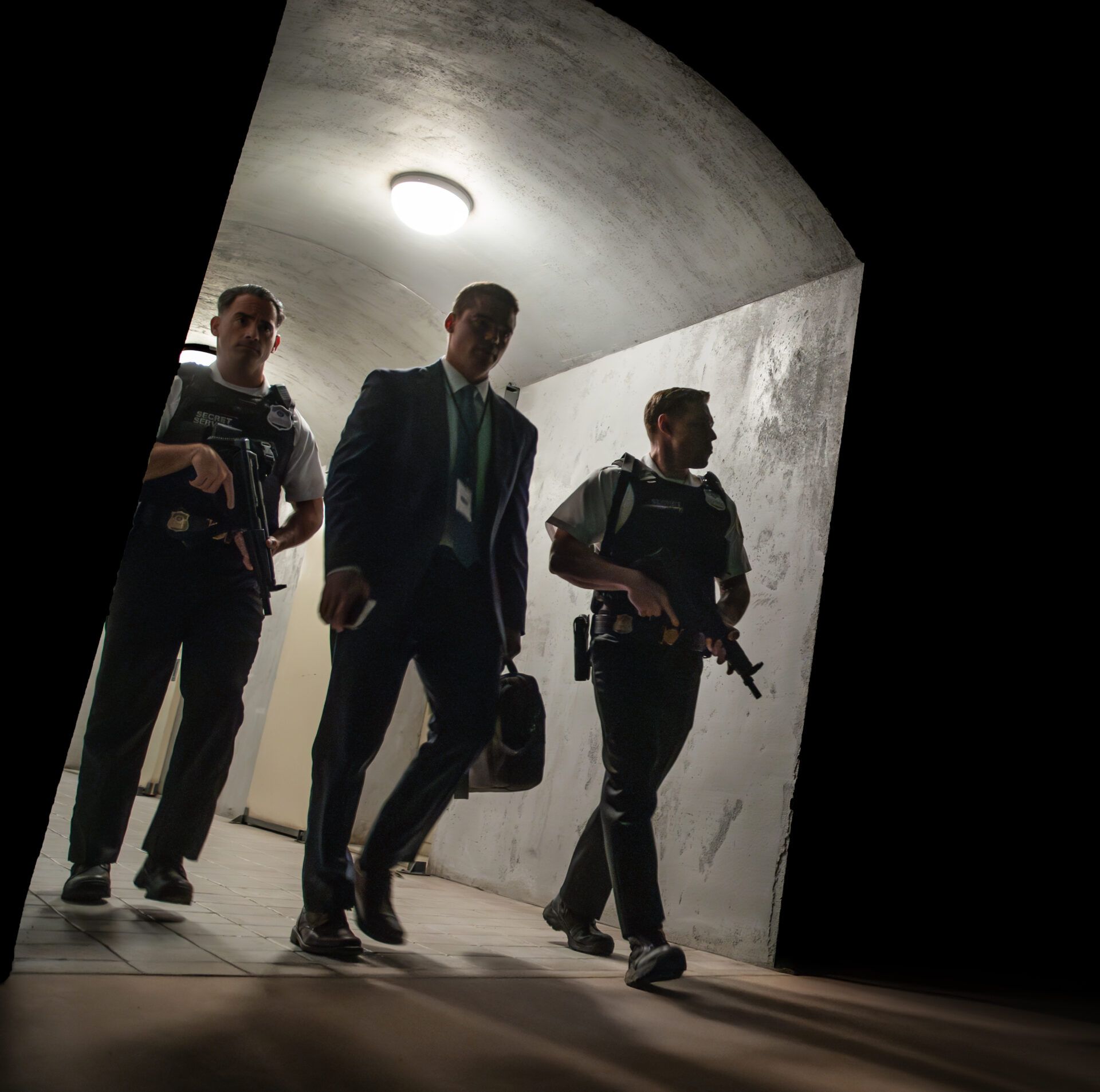 Gabriel Basso as Jake Baerington in “A House of Dynamite.” Photo credit: Eros Hoagland/Netflix © 2025.
Gabriel Basso as Jake Baerington in “A House of Dynamite.” Photo credit: Eros Hoagland/Netflix © 2025.
In the final frames of Kathryn Bigelow’s nuclear thriller A House of Dynamite, nothing explodes. The intercontinental ballistic missile has not made impact, the countdown is almost over, and the screen simply fades to black. No flash. No fire. No mushroom cloud.
Though only a single missile is shown, the film’s silence gestures toward the unspoken possibility that the unprovoked attack might trigger a full-scale nuclear exchange. The ambiguity of the US response leaves viewers suspended between an isolated incident and total annihilation.
The decision not to show the blast has haunted viewers since the film’s release. It’s a radical act of cinematic restraint in an era saturated in spectacle—a refusal that feels louder than any detonation. In that silence, A House of Dynamite confronts the same question that has shadowed nuclear culture for decades: What does it mean to imagine the unimaginable?
The Promethean gap. Responding to the new “nuclear age,” philosopher Günther Anders described a gap between what humanity can do and what it can imagine. He called this the “Promethean gap,” after the Greek mythological figure Prometheus, who stole fire from the gods and gave it to humans—unable to foresee the consequences of his actions.
Humans possess the means to destroy the world many times over, but we cannot truly picture that destruction. The gap between knowledge and belief, Anders warned, is deadly. We know what nuclear war would mean, but we don’t feel it. And if we cannot imagine it, we are less likely to prevent it.
That paradox is exactly where A House of Dynamite situates itself. By ending before impact, the film acknowledges that any image of nuclear annihilation would be false, an imaginative overreach. To depict the blast would be to pretend that we could see our own erasure. The film’s refusal becomes an ethical gesture: an acceptance that the apocalypse cannot be visualized without lying. As historian Paul Boyer once put it, the only adequate depiction of nuclear war “would be two hours of a totally blank screen.”
Total destruction cannot produce narrative. You can’t tell a story about the end of all stories.
And yet, we keep trying.
The cinema of nothingness. Across the history of nuclear cinema, the moments that strike deepest are often those of absence. The flash that cuts to white in the 1984 British television production Threads. The sudden blackout in the 1986 British animated disaster film When the Wind Blows. The unbearable silence at the end of the 1959 American drama On the Beach. Each gesture acknowledges the limits of representation.
Nuclear war is signified not by depiction, but by erasure.
A House of Dynamite inherits and amplifies that aesthetic lineage. In its closing seconds, it leans into what might be called the cinema of nothingness: a visual and auditory void that does the political work of representation through refusal. In the film’s final frames, sound drops out, the image burns to black, and we are left with silence.
Nothingness, here, is not an absence of meaning. It’s a site of confrontation. It demands that viewers reckon with what cannot be shown.
The “atomic shadows” left behind at Hiroshima and Nagasaki offer a chilling parallel. Those horrifying silhouettes—the outlines of bodies permanently seared into stone—are both presence and absence at once: the trace of a life and the mark of its erasure. They are evidence and void, memory and disappearance.
A House of Dynamite invokes that same paradox. Just as the atomic shadows of Hiroshima are “present yet absent,” the film’s blankness becomes its most eloquent image: a ghostly trace of what cannot be narrated. Its blank screen functions like a shadow: an imprint of what has happened, what had been, and what is lost. In both cases, the absence reveals the truth.
Cinema professor Akira Mizuta Lippit once described how the visuality of nuclear weapons evolved from a spectacular attack to a form of violent invisibility A House of Dynamite captures that transition. The most violent image is the one withheld. The blank screen becomes both wound and witness.
Endings that refuse to end. The film’s restraint also situates it within a broader cinematic tradition of ambiguous endings. As literary critic Frank Kermode argued, open endings deny closure, inviting the audience to participate in meaning-making. They transform art into a space of contemplation. In the nuclear context, such ambiguity carries ethical weight.
In A House of Dynamite, the apocalypse is neither averted nor resolved—it’s suspended. The film refuses the familiar narrative arc of destruction and rebirth. There is no “after.” The audience is stranded in the final instant before impact, where time collapses into pure anticipation.
This is the opposite of the “pseudo-apocalypses” that dominate much of popular culture: representations of “apocalypse” that are not really apocalyptic at all. As media scholar J. Jesse Ramírez observes, most end-of-the-world films smuggle in survival: the narrowly averted disaster, the heroic last-minute escape, or the post-apocalyptic rebirth. A House of Dynamite rejects all three. It doesn’t offer hope or catharsis. It leaves us with the unbearable unknown.
A House of Dynamite refuses the spectacle of nuclear detonation and its aftermath, exposing a central contradiction in nuclear storytelling. As English Studies professor Daniel Grausam wrote in his 2011 book On Endings, the apocalypse is “the event we must collectively think about and the event we have no narrative means to engage.”
By stopping just before the end, the film transforms anticipation into critique. This cinematic restraint does something rare: it turns absence into presence. The unseen explosion becomes a mirror for our collective imagination, reflecting both our fascination with the end and our inability to truly conceive it. Its final silence is not a full stop, but an ellipsis—a space of suspended meaning where the audience must imagine the unimaginable.
The politics of the blank screen. There’s also something profoundly political about this act of omission. To represent nothingness is still to make a choice—a gesture of framing, of perspective, of power. The film’s fade to black isn’t neutral; it’s a reminder that the unimaginable has been made that way through discourse, policy, and design.
In the nuclear age, the real violence often happens off-screen: in decision rooms, simulations, strategic documents, and classified silences. The missile that A House of Dynamite never shows has already been launched a thousand times in policy memos and deterrence doctrines. Its invisibility mirrors the bureaucratic abstraction of nuclear politics itself—a machinery of destruction hidden behind euphemisms like “counterforce” and “second strike capability.”
By refusing spectacle, the film denies us that abstraction. It collapses the safe distance between fiction and reality. It leaves us not entertained but implicated.
What happens after the end? The question is absurd, of course. The end, by definition, has no after. And yet that’s precisely where A House of Dynamite leaves us: stranded in the paradox of the aftermath that never arrives.
In Günther Anders’ words, nuclear catastrophe is a “not-imagined nothingness”: Humans are capable of ending the world but unable to imagine it. The film doesn’t show nuclear war. Instead, it shows us our own incapacity—the limits of imagination itself.
A House of Dynamite reminds us that the most haunting image of destruction is the one that never appears. In the quiet aftermath of its non-ending, the audience is left to feel the weight of what cannot be seen and to reckon with the silence that follows.
Ultimately, in refusing to show the end, the film shows us the truest image of all: ourselves, waiting in the dark.


